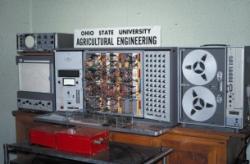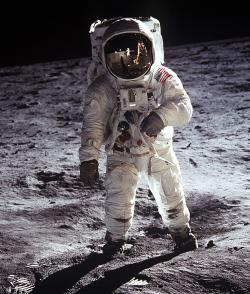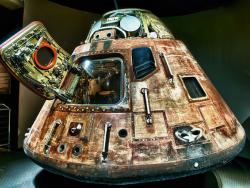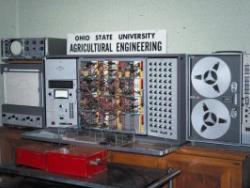The first laser grade control was developed by agricultural engineers James Fouss and Norman Fausey of USDA's Agricultural Research Service at The Ohio State University in the mid-1960's. That system controlled the precise depth and grade of subsurface drains by regulating trenching and plow-type drainage machines. Photo cells mounted on the drainage machine automatically raised and lowered the digging device, keeping the cells centered on a laser beam set to the desired elevation and grade.
1968

matic grade‐control system on the plow.

Apollo astronauts who ventured outside of the protective confines of their pressurized capsules faced a number of hazards, among them: exposure to cosmic debris, solar radiation, and surface temperatures that widely varied. The suit also needed to accommodate a wide range of motion to allow the duties of the missions to be successfully accomplished.

The 1992 Nobel Prize in physics was awarded to Georges Charpak, France, for his invention and development of detectors in high energy physics. Since 1959 Charpak had worked at CERN, the European laboratory for particle physics situated in the canton of Geneva in Switzerland. Charpak invented the multi - wire proportional chamber at CERN. The pioneering work was published in 1968. Largely due to his work particle physicists have been able to focus their interest on very rare particle interactions, which often reveal the secrets of the inner parts of matter.

6225 Vectorspace BlvdTitusvilleState: FLZip: 32780Country: USAWebsite: http://www.asme.org/about-asme/history/landmarks/topics-a-l/air-and-space-transportation/-162-apollo-space-command-module-%281968%29, http://nssdc.gsfc.nasa.gov/planetary/lunar/apollo14info.htmlCreator: North American Aviation
Innovations


The 1992 Nobel Prize in physics was awarded to Georges Charpak, France, for his invention and development of detectors in high energy physics. Since 1959 Charpak had worked at CERN, the European laboratory for particle physics situated in the canton of Geneva in Switzerland. Charpak invented the…
Read More
Apollo astronauts who ventured outside of the protective confines of their pressurized capsules faced a number of hazards, among them: exposure to cosmic debris, solar radiation, and surface temperatures that widely varied. The suit also needed to accommodate a wide range of motion to allow the…
Read More
The first laser grade control was developed by agricultural engineers James Fouss and Norman Fausey of USDA's Agricultural Research Service at The Ohio State University in the mid-1960's. That system controlled the precise depth and grade of subsurface drains by regulating trenching and…
Read More

